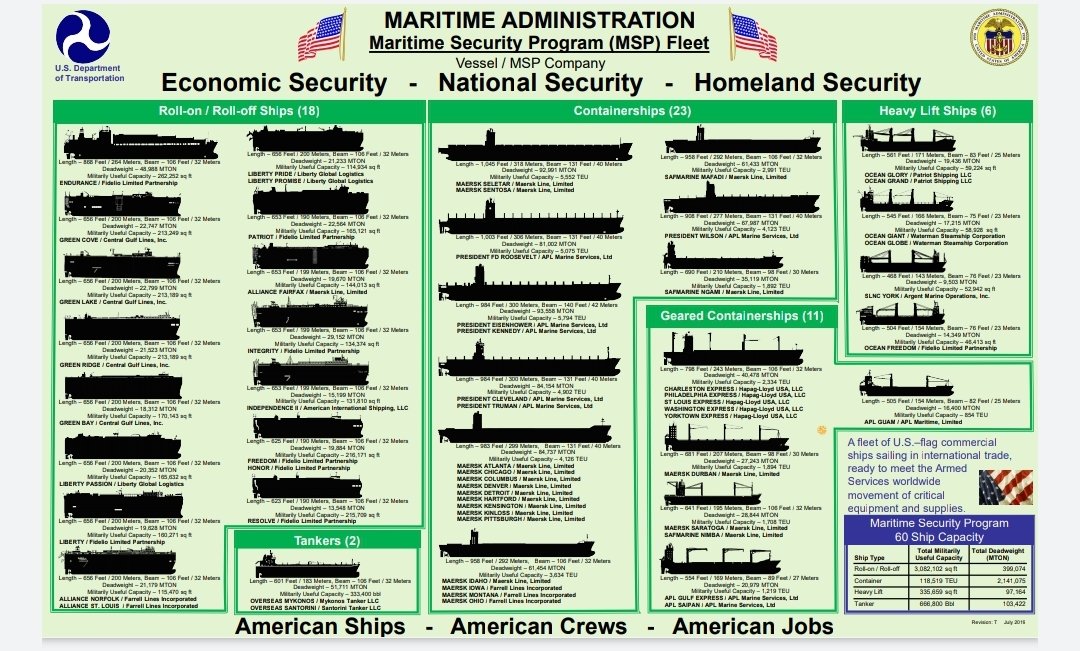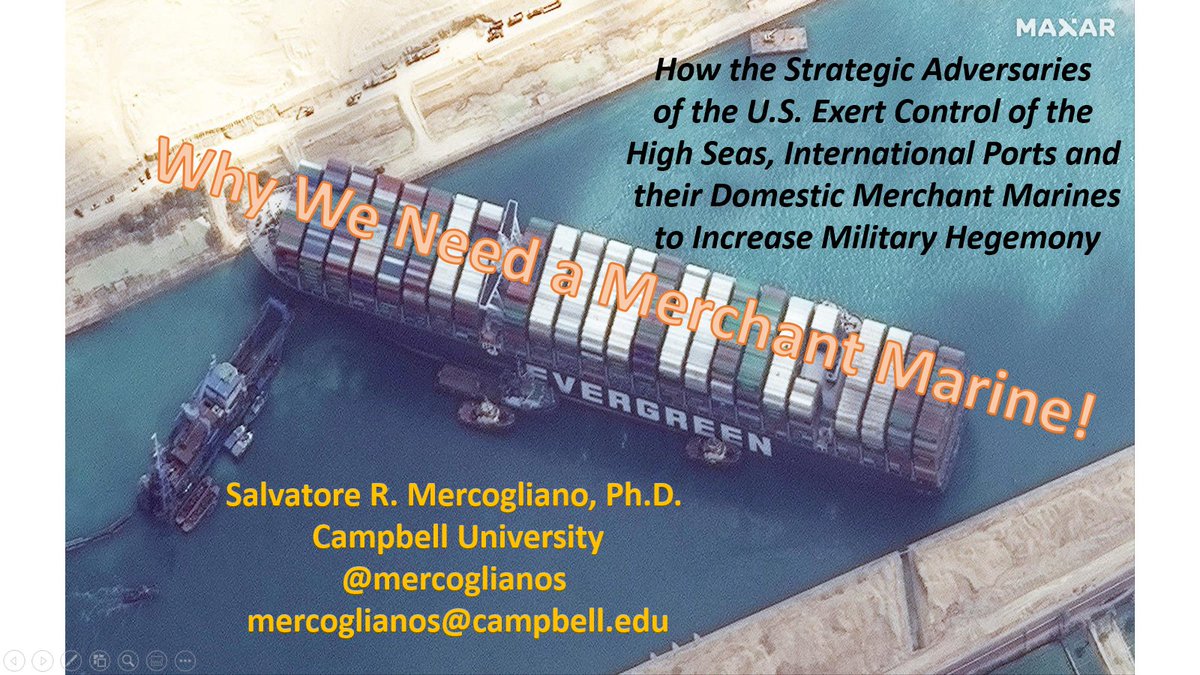
@jsnover @cpgrabow @robertcobrien 1/The decline of US merchant marine stems >WWII. In that conflict, the Merchant Marine Act of 1920 #JonesAct, along with acts of 1928 & 1936 provided the basis for the USMM to be 2nd largest in the world & in a position to transport the Arsenal of Democracy & build 2-Ocean Navy.
@jsnover @cpgrabow @robertcobrien 2/The US controlled 63% of world fleet >WWII, but the Ship Sales Act of 1946 sold US ships at a discounted rate to restock world fleets. Also the Marshall Plan 1948 permitted shipyards to be rebuilt and use the new prefab tech advocated by Henry J Kaiser.
@jsnover @cpgrabow @robertcobrien 3/Before entry into WWII, the US used the Panama registry as a means to avoid US Neutrality laws and deliver material and fuel to Britain prior to Lend Lease. Post war, Panama, along with Liberia as open registries on international routes with little oversight or regulation.
@jsnover @cpgrabow @robertcobrien 4/As far back as WWI, it was clear that US ships were more expensive to build and operate due to higher wages, domestic crewing requirements and unionization in many of the maritime industries. Add to it the Seamen's Act 1915 & NLRA 1935 that permitted unions, cost increaed.
@jsnover @cpgrabow @robertcobrien 5/Due to the Axis submarine offensive against America in 1942, there was a post war push to improve internal transport (akin to China's current Road initiative). Interstate highway and pipelines replaced the need for much #JonesAct shipping, thereby reducing #s built & operated.
@jsnover @cpgrabow @robertcobrien 6/The Vietnam War, and need for large amounts of US flag vessels to operate in under-developed ports, left many ships in service past their expected retirement. This marked a slide of the USMM from 5th to 9th place. The MMA 1970 aimed to build 300 ships in 10 years.
@jsnover @cpgrabow @robertcobrien 7/The credit crunch & inflation in the 1970s did not produce the requisite 300 ships. At the same time, rebuilt European & Asian yards were underbidding US yards & pulling US international trade vessels from American yards - such as Sea-Land SL-7, US Lines Econoships & APL D10s.
@jsnover @cpgrabow @robertcobrien 8/The Reagan Admin decision to end construction & differential subsidies for int trade meant the final push of US ships from domestic yards and reflagging. Along with 600-ship Navy coming exclusively into private yards, meant fewer commercial US ships, except for #JonesAct.
@jsnover @cpgrabow @robertcobrien 9/By the late 80s & 90s, you had the shakeout in American firms with many being bought by foreign firms - Sea-Land by Maersk, APL by NOL then CMA, along with several backruptcy's such as US Lines.
Success in the Persian Gulf War gave military a false sense of security.
Success in the Persian Gulf War gave military a false sense of security.
@jsnover @cpgrabow @robertcobrien 10/By the late 1990s & early 2000s it appeared that US international trade would cease on US flag ships. The Oil Pollution Act of 1990 required double hull tankers & prompted construction of replacements in US yards. DOD advocated the Maritime Security Program to pay op subsidy. 

@jsnover @cpgrabow @robertcobrien 11/The MSP initially only provided for 47 ships, later expanded to 60. These ships, along with those in the @DOTMARAD @MSCSealift @US_TRANSCOM surge fleet were essential to success in Iraq & Afghanistan from 2001 to 2011. However, MSP did not provide for domestic shipbuilding.
@jsnover @cpgrabow @robertcobrien @DOTMARAD @MSCSealift @US_TRANSCOM 12/Today, the US finds itself as a global superpower without the merchant marine or maritime infrastructure to support itself in a potential peer-to-peer conflict as it has in the past.
The US Navy is #1 & merchant marine is #21, while China is #2 in both.
usni.org/magazines/proc…
The US Navy is #1 & merchant marine is #21, while China is #2 in both.
usni.org/magazines/proc…
@jsnover @cpgrabow @robertcobrien @DOTMARAD @MSCSealift @US_TRANSCOM 13/Some will lay the decline of the merchant marine on solely the #JonesAct, but that is disengenous as the MMA 1920 created the first national maritime stategy. What has transpired over the past 101 years is the lack of maintaining & updating a stategy.
threader.app/thread/1400894…
threader.app/thread/1400894…
@jsnover @cpgrabow @robertcobrien @DOTMARAD @MSCSealift @US_TRANSCOM 14/The question that needs to be asked who directly benefits from a repeal of the #JonesAct?
American goods will not divert onto ships along the coasts - look at the constraints in US ports & cost vs truck. 85% Container trade is concentrated in 10 companies - none are US owned.

American goods will not divert onto ships along the coasts - look at the constraints in US ports & cost vs truck. 85% Container trade is concentrated in 10 companies - none are US owned.


@jsnover @cpgrabow @robertcobrien @DOTMARAD @MSCSealift @US_TRANSCOM 15/The most tri-naval strategy discusses issues relating to the @USNavy @USMC @USCG, but fail to address commercial issues regarding USshipbuilding, repair facilities, commerical domestic/international shipping & how to accomplish sealift missions.
brookings.edu/research/impli…
brookings.edu/research/impli…
@jsnover @cpgrabow @robertcobrien @DOTMARAD @MSCSealift @US_TRANSCOM @USNavy @USMC @USCG 16/There is a lot of mone being invested to benefit foreign shipping companies - look at attempts to repeal the Passenger Vessel Services Act - that will benefit Carnival, RCL & Norwegian that control 74.3% passenger market, but are incorporated in Panama, Liberia & Bermuda.
@jsnover @cpgrabow @robertcobrien @DOTMARAD @MSCSealift @US_TRANSCOM @USNavy @USMC @USCG 17/What is needed is the development of a new MARITIME strategy that does not surrender American maritime infrastructure overseas & make US more dependent on foreign shipping & corporations. There needs to be accommodations from all concerned parties.
gcaptain.com/100-years-of-t…
gcaptain.com/100-years-of-t…
@jsnover @cpgrabow @robertcobrien @DOTMARAD @MSCSealift @US_TRANSCOM @USNavy @USMC @USCG @threader_app
Compile
Compile
• • •
Missing some Tweet in this thread? You can try to
force a refresh







